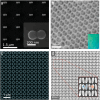Molecular spectroscopies with semiconductor metasurfaces: towards dual optical/chemical SERS
- PMID: 40417182
- PMCID: PMC12096842
- DOI: 10.1039/d4tc05420b
Molecular spectroscopies with semiconductor metasurfaces: towards dual optical/chemical SERS
Abstract
Surface-enhanced Raman spectroscopy (SERS) has emerged as a powerful technique for the ultra-sensitive detection of molecules and has been widely applied in many fields, ranging from biomedical diagnostics and environmental monitoring to trace-level detection of chemical and biological analytes. While traditional metallic SERS substrates rely predominantly on electromagnetic field enhancement, emerging semiconductor SERS materials have attracted growing interest because they offer the additional advantage of simultaneous chemical and electromagnetic enhancements. Here, we review some of the recent advancements in the design and optimization of semiconductor SERS substrates, with a focus on their dual enhancement mechanisms. We also discuss the transition from nanoparticle-based platforms to more advanced nanoresonator-based SERS metasurfaces, highlighting their superior sensing performance.
This journal is © The Royal Society of Chemistry.
Conflict of interest statement
There are no conflicts to declare.
Figures






Similar articles
-
Defect engineering in semiconductor-based SERS.Chem Sci. 2021 Dec 1;13(5):1210-1224. doi: 10.1039/d1sc05940h. eCollection 2022 Feb 2. Chem Sci. 2021. PMID: 35222907 Free PMC article. Review.
-
Semiconductor-based surface enhanced Raman scattering (SERS): from active materials to performance improvement.Analyst. 2022 Mar 28;147(7):1257-1272. doi: 10.1039/d1an02165f. Analyst. 2022. PMID: 35253817 Review.
-
SERS Activity of Semiconductors: Crystalline and Amorphous Nanomaterials.Angew Chem Int Ed Engl. 2020 Mar 9;59(11):4231-4239. doi: 10.1002/anie.201913375. Epub 2019 Dec 16. Angew Chem Int Ed Engl. 2020. PMID: 31733023 Review.
-
Synthesis and defect engineering of molybdenum oxides and their SERS applications.Nanoscale. 2021 Mar 21;13(11):5620-5651. doi: 10.1039/d0nr07779h. Epub 2021 Mar 10. Nanoscale. 2021. PMID: 33688873
-
Surface-Enhanced Raman Spectroscopy (SERS)-Based Sensors for Deoxyribonucleic Acid (DNA) Detection.Molecules. 2024 Jul 16;29(14):3338. doi: 10.3390/molecules29143338. Molecules. 2024. PMID: 39064915 Free PMC article. Review.
References
Publication types
LinkOut - more resources
Full Text Sources
Miscellaneous
